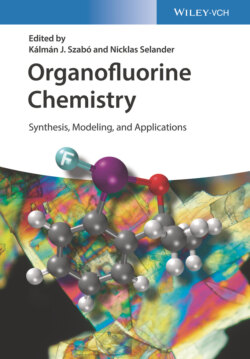Читать книгу Organofluorine Chemistry - Группа авторов - Страница 26
2.2.2 Reactions Using XeF2
ОглавлениеSome early examples of perfluoroalkylations with perfluorocarboxylic acids used XeF2 as an activator to generate perfluoroalkyl radicals. Eisenberg and DesMarteau reported that xenon fluoride trifluoroacetate and xenon bis(trifluoroacetate), which detonate when thermally or mechanically shocked, were prepared by the reaction of trifluoroacetic acid and XeF2. These compounds were found to give hexafluoroethane via decomposition on standing at 23 °C [27]. Zupan and coworker reported that in the course of studies on alkene fluorination using XeF2 in the presence of trifluoroacetic acid, styrene was transformed into trifluoromethylated products together with fluorination products (Scheme 2.15) [28].
Scheme 2.15 Trifluoromethylation of alkene. in the presence of XeF2
In addition, diphenylacetylene gave 1‐(trifluoromethyl)‐2‐(trifluoroacetoxy)‐1,2‐diphenylethylene and 1‐fluoro‐2‐(trifluoromethyl)‐1,2‐diphenylethylene, although the yields were low. It was suggested that the reaction proceeds via trifluoromethyl radical generation from xenon trifluoroacetate species. In 1988, Matsuo developed an efficient perfluoroalkylation of electron‐deficient and heterocyclic aromatic compounds with perfluorocarboxylic acids promoted by XeF2 (Scheme 2.16) [29]. More than 10 perfluoroalkylated products, including trifluoromethyl derivatives, were synthesized in up to 72% yield. Popkov applied Matsuo's conditions to the synthesis of trifluoromethylated furan and thiophene derivatives in order to evaluate their activity against phytopathogenic fungi in vitro [30].
Scheme 2.16 Perfluoroalkylation of heterocyclic aromatic compounds.
